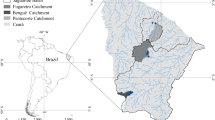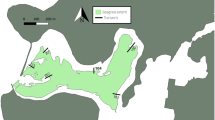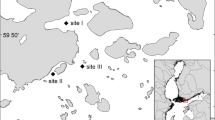Abstract
The present study aims to test the application of remote sensing to address the impact of bioturbation on physical sediment properties. Therefore, a laboratory experiment was developed, using microcosms mimicking a marine intertidal water–sediment interface to test the influence of Corophium volutator densities on sediment properties. Three main variables (water content, clay content, and mean grain size) were measured in three treatments (no Corophium, 5,000 Corophium per square meter, and 20,000 Corophium per square meter) after 16 days of bioturbation. Results obtained with conventional—destructive—techniques showed a significant increase of water content and a significant, but small decrease of clay content in the presence of Corophium. The remote sensing technique detected the impact of Corophium on water content as an increase in absorption at 1,450 nm, but was not able to detect the animal impact on clay content. This study demonstrates that remote sensing data could be significantly modified by bioturbation activities and that remote sensing can be applied in the laboratory to address the impact of bioturbation on sediment properties. This possibly opens new perspectives for long-term experiments concerning the role of bioturbation on sedimentary processes.






Similar content being viewed by others
References
Adam, S. 2009. Bio-physical characterization of sediment stability indicators for mudflats using remote sensing. Ph.D. thesis, Katholieke Universiteit Leuven, 162 p + appendices.
Adam, S., I. Vitse, C. Johannsen, and J. Monbaliu. 2006. Sediment type unsupervised classification of the Molenplaat, Westerschelde Estuary, The Netherlands. EARSeL eProceedings 5: 146–160.
Adam, S., J. Monbaliu, and E. Toorman. 2008. Quantification of bio-physical intertidal sediment properties using hyperspectral laboratory and in situ measurements. In 28th EARSeL Symposium and Workshops, Remote Sensing for a Changing Europe, 2–7 June, Istanbul.
Aller, R.C. 1982. The effects of macrobenthos on chemical properties of marine sediment and overlying water. In Animal–sediment relations, ed. P.L. Mc Call and M.J.S. Tevest, 53–102. New York: Plenum.
Ben-dor, E., K. Patkin, A. Banin, and A. Karnieli. 2002. Mapping of several soil properties using DAIS-7915 hyperspectral scanner data—a case study over clayey soils in Israel. International Journal of Remote Sensing 23: 1043–1062.
Boates, J.S., M. Forbes, M. Zinck, and N. McNeil. 1995. Male amphipods Corophium volutator (Pallas) show flexible behaviour in relation to risk of predation by sandpipers. Ecoscience 2(2): 123–128.
Carrère, V. 2003. Mapping microphytobenthos in the intertidal zone of Northern France using high spectral resolution field and airborne data. Presented at the 3rd EARSeL Workshop on Imaging Spectroscopy, Herrsching, 13–16 May.
Carrère, V., N. Spilmont, and D. Davouli. 2004. Comparison of simple techniques for estimating chlorophyll a concentration in the intertidal zone using high spectral-resolution field-spectrometer data. Marine Ecology Progress Series 274: 31–40.
Chapman, M.G. and T.J. Tolhurst. 2004. The relationship between invertebrate assemblages and bio-dependent properties of sediment in urbanized temperate mangrove forests. Journal of Experimental Marine Biology and Ecology 304: 51–73.
Clark, R.N. and T. Roush. 1984. Reflectance spectroscopy: quantitative analysis techniques for remote sensing applications. Journal of Geophysical Research 89: 6329–6340.
Combe, J.-P., P. Launeau, V. Carrère, D. Despan, V. Méléder, L. Barillé, and C. Sotin. 2005. Mapping microphytobenthos biomass by non-linear inversion of visible-infrared hyperspectral images. Remote Sensing of Environment 98: 371–387.
De Backer, A., E. Van Ael, M. Vincx, and S. Degraer. 2006. The secret life of Corophium volutator, an important bioturbator on mudflats. In VLIZ Young Scientists' Day, Brugge, Belgium, 31 March 2006: Book of Abstracts. VLIZ Special Publication 30, ed. J. Mees, and J. Seys, 27 Oostende: VLIZ (Vlaams Instituut voor de Zee).
de Deckere, E.M.G.T., J. van de Koppel, and C.H.R. Heip. 2000. The influence of Corophium volutator abundance on resuspension. Hydrobiologia 426: 37–42.
Defew, E.C., T.J. Tolhurst, and D.M. Paterson. 2002. Site-specific features influence sediment stability of intertidal flats. Hydrology and Earth System Sciences 6(5): 971–982.
Defew, E.C., T.J. Tolhurst, D.M. Paterson, and S.E. Hagerthey. 2003. Can the stability of intertidal sediments be predicted from proxy parameters? An in situ investigation, 61–70. Leamington Spa: Estuarine and Coastal Sciences Association.
Deronde, B., P. Kempeneers, and R.M. Forster. 2006. Imaging spectroscopy as a tool to study sediment characteristics on a tidal sandbank in the Westerschelde. Estuarine, Coastal and Shelf Science 69: 580–590.
Gerdol, V. and R.G. Hughes. 1994a. Feeding behaviour and diet of Corophium volutator in an estuary in southeastern England. Marine Ecology Progress Series 114: 103–108.
Gerdol, V. and R.G. Hughes. 1994b. Effect of Corophium volutator on the abundance of benthic diatoms, bacteria and sediment stability in two estuaries in southeastern England. Marine Ecology Progress Series 114: 109–115.
Grant, J. and G. Daborn. 1994. The effects of bioturbation on sediment transport on an intertidal mudflat. Netherlands Journal of Sea Research 32(1): 63–72.
Hall, S.J. 1994. Physical disturbance and marine benthic communities: life in unconsolidated sediments. Oceanography and Marine Biology. Annual Review 32: 179–219.
Hunt, G.R. 1977. Spectral signatures of particulate minerals in the visible and near-infrared. Journal of Geophysical Research 95: 12653–12680.
Jones, S.E. and C.F. Jago. 1993. In situ assessment of modification of sediment properties by burrowing invertebrates. Marine Biology 115: 133–142.
Jones, C.G., J.H. Lawton, and M. Shachak. 1994. Organisms as ecosystem engineers. Oikos 69: 373–386.
Kooistra, L., J. Wanders, G.F. Epema, R.S.E.W. Leuven, R. Wehrens, and L.M.C. Buydens. 2003. The potential of field spectroscopy for the assessment of sediment properties in river floodplains. Analytica Chimica Acta 484: 189–200.
Lagacherie, P., F. Baret, J.-B. Feret, J. Madeira Netto, and J.M. Robbez-Masson. 2008. Estimation of soil clay and calcium carbonate using laboratory, field and airborne hyperspectral measurements. Remote Sensing of Environment 112: 825–835.
Lillesand, T.M. and R.W. Kiefer. 2000. Remote sensing and image interpretation, vol. 4. New York: Wiley.
Limia, J. and D. Raffaelli. 1997. The effects of burrowing by the amphipod Corophium volutator on the ecology of intertidal sediments. Journal of the Marine Biological Association of the UK 77: 409–423.
Lohrer, A.M., S.F. Thrush, and M.M. Gibbs. 2004. Bioturbators enhance ecosystem function through complex biogeochemical interactions. Nature 43: 1092–1095.
Meadows, P.S. and A. Meadows. 1991. The geotechnical and geochemical implications of bioturbation in marine sedimentary ecosystems. Symposia of the Zoological Society of London 63: 157–181.
Meadows, P.S. and A. Reid. 1966. The behaviour of Corophium volutator (Crustacea: Amphipoda). Journal of Zoology 150: 387–399.
Meadows, P.S. and J. Tait. 1989. Modification of sediment permeability and shear strength by two burrowing invertebrates. Marine Biology 101: 75–82.
Meadows, P.S., J. Tait, and S.A. Hussain. 1990. Effects of estuarine infauna on sediment stability and particle sedimentation. Hydrobiologia 190: 263–266.
Méléder, V., L. Barillé, P. Launeau, V. Carrère, and Y. Rincé. 2003. Spectrometric constraint in analysis of benthic diatom biomass using monospecific cultures. Remote Sensing of Environment 88: 386–400.
Mermillod-Blondin, F., R. Rosenberg, F. Francois-Carcaillet, K. Norling, and L. Mauclaire. 2004. Influence of bioturbation by three benthic infaunal species on microbial communities and biogeochemical processes in marine sediment. Aquatic Microbial Ecology 36(3): 271–284.
Mermillod-Blondin, F., F. François-Carcaillet, and R. Rosenberg. 2005. Biodiversity of benthic invertebrates and organic matter processing in shallow marine sediments: an experimental study. Journal of Experimental Marine Biology and Ecology 315(2): 187–209.
Meysman, F.J., J.J. Middelburg, and C.H. Heip. 2006. Bioturbation: a fresh look at Darwin's last idea. Trends in Ecology and Evolution 21(12): 688–695.
Murdoch, M.H., F. Bärlocher, and M.L. Laltoo. 1986. Population dynamics and nutrition of Corophium volutator (Pallas) in the Cumberland Basin (Bay of Fundy). Journal of Experimental Marine Biology and Ecology 103: 235–249.
Murphy, R.J., T.J. Tolhurst, M.G. Chapman, and A.J. Underwood. 2005. Estimation of surface chlorophyll a on an emersed mudflat using field spectrometry: accuracy of ratios and derivative-based approaches. International Journal of Remote Sensing 26: 1835–1859.
Neema, D.L., A. Shah, and A.N. Patel. 1987. A statistical optical model for light reflection and penetration through sand. International Journal of Remote Sensing 8(8): 1209–1217.
Pelegri, S.P. and T.H. Blackburn. 1994. Bioturbation effects of the amphipod Corophium volutator on microbial nitrogen transformations in marine sediments. Marine Biology 121: 253–258.
Orvain, F., R. Galois, C. Barnard, A. Sylvestre, G. Blanchard, and P.G. Sauriau. 2003. Carbohydrate production in relation to microphytobenthic biofilm development: an integrated approach in a tidal mesocosm. Microbial Ecology 45(3): 237–251.
Rainey, M.P., A.N. Tyler, D.J. Gilvear, R.G. Bryant, and P. McDonald. 2003. Mapping intertidal estuarine grain size distributions through airborne remote sensing. Remote Sensing of Environment 86: 480–490.
Rhoads, D.C. 1974. Organism–sediment relations on the muddy sea floor. Oceanography and Marine Biology. Annual Review 12: 263–300.
Riethmüller, R., J.H.M. Hakvoort, M. Heineke, K. Heymann, H. Kühl, and G. Witte. 1998. Relating erosion thresholds to tidal flat surface colour. In Sedimentary processes in the intertidal zone, eds. K.S. Black, D.M. Paterson, and A. Cramp. Journal of the Geological Society of London (Special Issue) 139: 283–293.
Rowden, A.A., C.F. Jago, and S.E. Jones. 1998. Influence of benthic macrofauna on the geotechnical and geophysical properties of surficial sediment, North Sea. Continental Shelf Research 18: 1347–1363.
Thomson, A.G., J.A. Eastwood, M.G. Yates, R.M. Fuller, R.A. Wadsworth, and R. Cox. 1998. Airborne remote sensing of intertidal biotopes: BIOTA I. Marine Pollution Bulletin 37: 164–172.
van der Wal, D. and P.M.J. Herman. 2007. Regression-based synergy of optical, shortwave infrared and microwave remote sensing for monitoring the grain-size of intertidal sediments. Remote Sensing of Environment 111: 89–106.
van der Wal, D., P.M.J. Herman, R.M. Forster, T. Ysebaert, F. Rossi, E. Knaeps, Y.M.G. Plancke, and S.J. Ides. 2008. Distribution and dynamics of intertidal macrobenthos predicted from remote sensing: response to microphytobenthos and environment. Marine Ecology Progress Series 367: 57–72.
Weidong, L., F. Baret, G. Xingfa, T. Qingxi, Z. Lanfen, and Z. Bing. 2002. Relating soil surface moisture to reflectance. Remote Sensing of Environment 81: 238–246.
Wiltshire, K.H., S. Harsdorf, B. Smidt, G. Blocker, R. Reuter, and F. Schroeder. 1997. The determination of algal biomass (as chlorophyll) in suspended matter from the Elbe Estuary and the German Bight: a comparison of high-performance liquid chromatography, delayed fluorescence and prompt fluorescence methods. Journal of Experimental Marine Biology and Ecology 222: 113–131.
Yang, K., J.F. Huntington, P.R.L. Browne, and C. Ma. 2000. An infrared spectral reflectance study of hydrothermal alteration minerals from the Te Mihi Sector of the Wairakei Geothermal System, New Zealand. Geothermics 29: 377–392.
Yates, M.G., A.R. Jones, S. McGrorty, and J.D. Goss-Custard. 1993. The use of satellite imagery to determine the distribution of intertidal surface sediments of the Wash, England. Estuarine, Coastal and Shelf Science 36: 333–344.
Acknowledgements
The first author acknowledges a research assistant grant from Ghent University (UGent). The second author was financed through the FWO-Vlaanderen (Research Foundation—Flanders) project KISS (contract no. G.0480.05) and the Belgian Federal Science Policy in the frame of the STEREO program—project 109 (Algased). This research contributes to the EU Network of Excellence MarBEF (contract no. GOCE-CT-2003-505446) and the Ghent University BBSea project (contract no. GOA 01G00705). Furthermore, we thank the Flemish authorities (ANB) for the permission to sample in the Nature Reserve “IJzermonding.” Two anonymous reviewers provided many useful suggestions and recommendations to improve the final manuscript.
Author information
Authors and Affiliations
Corresponding author
Rights and permissions
About this article
Cite this article
De Backer, A., Adam, S., Monbaliu, J. et al. Remote Sensing of Biologically Reworked Sediments: A Laboratory Experiment. Estuaries and Coasts 32, 1121–1129 (2009). https://doi.org/10.1007/s12237-009-9204-6
Received:
Revised:
Accepted:
Published:
Issue Date:
DOI: https://doi.org/10.1007/s12237-009-9204-6




